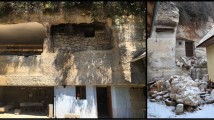Abstract
This paper presents an investigation of the decay of bricks in the chancel vault of Brarup Church located close to the Baltic Sea at the island of Falster in Denmark. The aim of the work was to study a peculiar phenomenon in order to prescribe appropriate treatment. Although protected by a lime plaster, some bricks were pulverized up to 50 mm deep from the topside. The decay occurred in a random pattern over the structure, with undamaged bricks positioned next to deteriorated bricks. The brick structure was investigated by Mercury Intrusion Porosiometry. All bricks had a majority of pores in the range 1–10 μm, but the decayed bricks also had a fraction of pores with a diameter less than 100 nm. The difference may be due to a lower firing temperature, or it may be a consequence of the salt decay. Salt analysis proved that the deteriorated bricks were contaminated with sodium chloride, which could have degraded the brick structure. However, the powdering of the bricks may be caused by the precipitation of gypsum, which was found in the brick powder but not in the deteriorated brick itself. According to calculations with the computer program RUNSALT, the precipitation of gypsum is much influenced by the presence of sodium chloride. The gypsum precipitates due to changes in temperature between 0 and 30°C and variations in relative humidity between 75 and 95%. Seasonal climatic changes in the attic were measured to cover this interval. Perhaps sodium chloride acted as a catalyst that facilitated the accumulation and precipitation of gypsum at the topside of the bricks. A sacrificial plaster, which is the traditional treatment for salt contaminated structures, would not prevent such decay.













Similar content being viewed by others
References
Binda L, Baronio G (1987) Mechanisms of masonry decay due to salt crystallisation. Durab Build Mater 4:227–240
Flatt RJ (2002) Salt damage in porous materials how high super saturations are generated. J Crystal Growth 242:435–454
Franke L, Bentrup H, Schumann I (1993) Ursachen der Steinschädigung an historischen Bachsteinbauten in Norddeutchland, Teil 1 + 2. Bautenschutz + Bausanierung 16:13–16, 45–48
Harvie CE, Weare JH (1980) The prediction of mineral solubilities in natural waters; the Na–K–Mg–Ca–Cl–SO4–H2O system from zero to high concentration at 25°C. Geochim Cosmochim Acta 44:981–997
Klenz Larsen P (1999) Desalination of a painted brick vault in Kirkerup Church. In: Proceedings of ICOM-CC 12th Triennial Meeting Lyon 29, vol II, pp 473–77
Klenz Larsen P (2002) The use of passive climate control to prevent salt decay in Rørby Church. In: von Konow T (ed) The study of salt deterioration mechanisms. Decay of brick walls influenced by the interior climate changes. European Heritage Laboratories, Raphaël, pp 103–107
Lubelli B, van Hees RPJ, Groot CJWP (2004) The role of sea salts in the occurrence of different damage mechanisms and decay patterns on brick masonry. Constr Build Mater 18:119–124.
Nielsen CB (1991) Salt in porous building materials. Technical report 243/91. PhD Thesis. The Technical University of Denmark, Laboratory of Building Materials
Price C (ed) (2000) An expert chemical model for determining the environmental conditions needed to prevent salt damage in porous materials. Project ENV4-CT95-0135, final report, research report no. 11, the European Commission
Price CA, Brimblecombe P (1994) Preventing salt damage in porous materials. In: Preventive conservation, theory, practice and research. Preprints of the contribution to the Ottowa Congress, IIC, 1009, pp 90–93
Rijniers L (2004) Salt crystallisation in porous materials. PhD Thesis. Technische Universitet Eindhoven
Rodriguez-Navarro C, Doehne E, Sebastian E (2000) How does sodium sulphate crystallise? Implications for the decay and testing of building materials. Cement Concr Res 30:1527–1534
Schlütter F, Steiger M, Juling H (2002) Schädigung von chlorid- und nitratbelastetem Ziegelmauerwerk. Kryo-REM-Untersuchungen zur Wirkungsweise eines Salzgemisches. In: Leitner H et al (eds) Mauersalze und Architekturoberflächen. Tagungsbeitrage, Hochschule für Bildende Künste, Dresden, pp 72–78
Schumann I (1997) zur nachträglichen Bestimmung der Brenntemperatur und zum Einfluss der Brenntemperatur auf die chemische Beständigkeit von Ziegeln. Dissertation. Technischen Universität Hamburg-Harburg
Steiger M, Zeunert A (1996) Crystallisation properties of salt mixtures: comparison of experimental results and model calculations. In: Riederer J (ed) Proceeding of the 8th international congress on deterioration and conservation of stone, 30 september–4 october 1996, vol 1, pp 535–544
Stoklund Larsen E (1987) Mursalte. Kvalitativ og kvantitativ undersøgelse af salte i teglsten fra vestjyske middelalderkirker. Technical report 181/88. The Technical University of Denmark, Building Materials Laboratory
Von Konow T (1989) Saltvittring i tegel – saltvittringsmekanismer (Salt decay in brick—mechanisms of salt decay). Theses. Technical Research centre of Finland. Research notes 1003
Wendler E (2002) Laboratory measurement on salt loaded brick samples in periodically changing climate conditions. In: von Konow T (ed) The study of salt deterioration mechanisms. Decay of brick walls influenced by the interior climate changes. European Heritage Laboratories, Raphaël, pp 81–87
Author information
Authors and Affiliations
Corresponding author
Rights and permissions
About this article
Cite this article
Klenz Larsen, P. The salt decay of medieval bricks at a vault in Brarup Church, Denmark. Environ Geol 52, 375–383 (2007). https://doi.org/10.1007/s00254-006-0586-5
Received:
Accepted:
Published:
Issue Date:
DOI: https://doi.org/10.1007/s00254-006-0586-5




